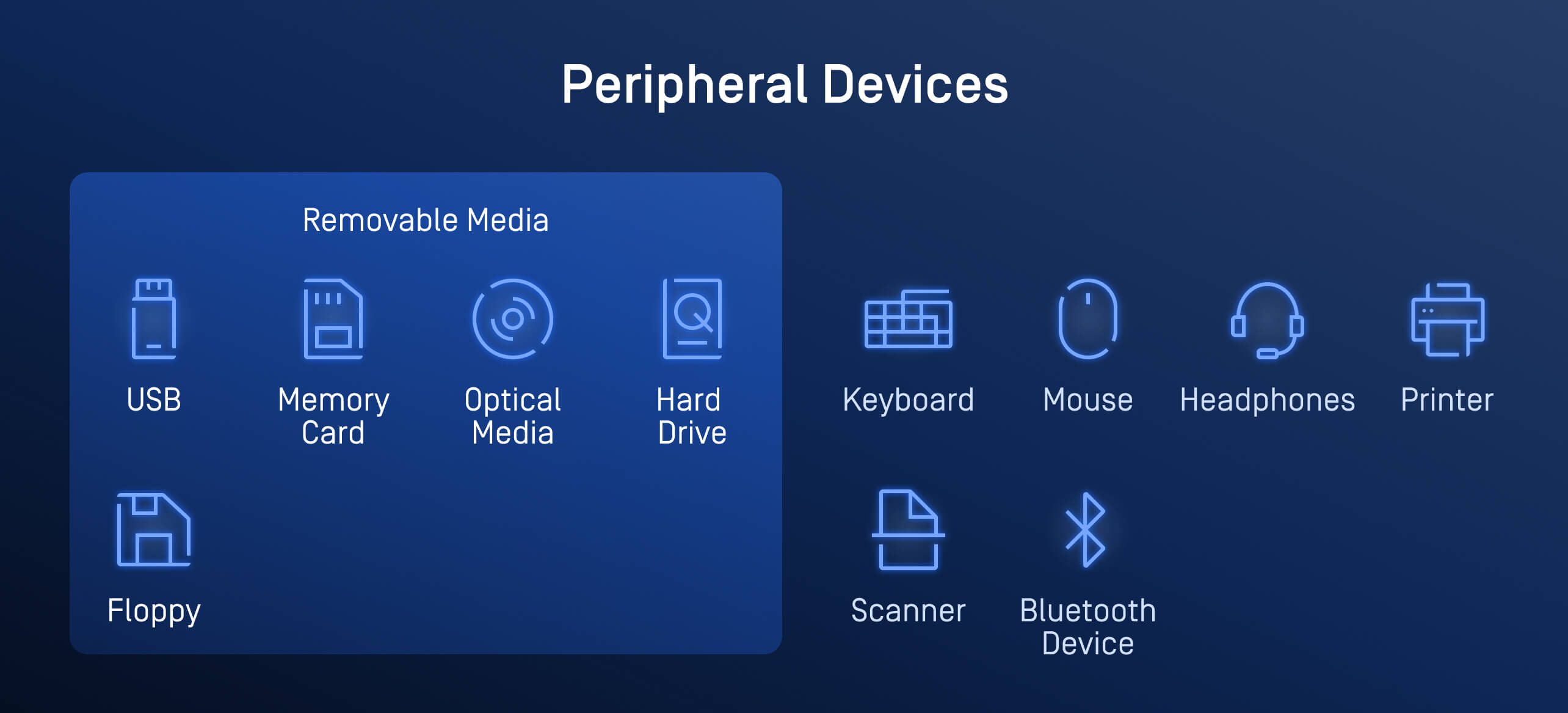We’ve all heard the stories—whether they start with an employee finding a USB drive in the parking lot or a vendor unknowingly transporting files containing malware on something as seemingly innocuous as a floppy disk—the risks around popular forms of removable media are table stakes when it comes to developing cybersecurity strategies to defend critical environments.
Those common portable media types, thumb drives, floppy disks, Blu-ray discs, SD cards, and the like, are only part of the equation. While these components comprise the lion’s share of this threat vector, they fall under the larger category of peripheral devices and removable media; a complex challenge the cybersecurity world needs to solve in order to protect critical environments.
In this blog, let’s take a closer look at what defines peripheral device and removable media protection, why it’s important, and some key principles your organization should focus on to address and mitigate the associated risks.
What is Peripheral Device and Removable Media Protection?
Peripheral device and removable media protection refers to securing external devices that can be connected to computer systems and industrial assets. While common removable media types such as USB drives, external hard drives, CDs, SD cards, floppy disks, and other popular storage medium are among those covered here, this key term includes other devices as well. Bluetooth connected devices like keyboards, mice, and headphones, as well as wireless and wired devices like printers and scanners are also considered peripherals. These peripheral devices serve as conduits for power delivery, data transfer, and interface, allowing users to conveniently store, share, input, and/or transport information.

Removable Media is Essential
Critical infrastructure sectors such as energy, manufacturing, transportation, healthcare, and finance (to name a few) rely heavily on removable media to update and maintain critical systems and networks. Any disruption or breach within these sectors can have far-reaching consequences, including financial losses, operational downtime, and compromised public safety.
In many cases, the critical assets that these industries rely on to run operations live on an air-gapped network for added security. This means that to keep these isolated assets up-to-date or to perform regular maintenance, patches and other software must cross the air gap via removable media to reach them. One cannot simply upload or download directly to these assets as the air-gapped networks are not connected to the outside internet. That’s why these necessary files, binaries, and executables are brought over via removable media—opening critical networks to a world of vulnerabilities.
Preventing Threats
The malicious files carried on forms of peripheral and removable media are akin to the army waiting to attack from inside the legendary Trojan Horse; they’re hiding inside things we take for granted, and without the right methodologies in place, they can infiltrate an organization’s secure network and bring them to their knees. Here are just some of the reasons why preventing these kinds of attacks is so critical in modern cybersecurity:

Malware Mitigation
External devices can serve as entry points for malware and other cyberthreats. Implementing multilayered peripheral and removable media protection measures to scan these devices before use within a critical or production network can help mitigate the spread of malware within critical infrastructure networks.

Staying Compliant
Key regulatory bodies around the world have their eyes on peripheral and removable media threats. With the attack surface rapidly spreading, organizations that don’t take these vulnerabilities seriously can be hit with hefty fines that, outside of the financial loss, can come with irreparable reputational damage as well. See how peripheral and removable media security helps organizations stay compliant with NERC CIP in North America.

Operational Continuity
Maintaining the integrity and availability of critical infrastructure systems is crucial for uninterrupted operations. By securing peripheral and removable media and enforcing security measures, organizations can minimize the risk of disruptions caused by malicious activities or data loss.

Data Protection
Critical infrastructure systems often handle sensitive and confidential information. Safeguarding peripheral and removable media helps prevent unauthorized access to this data, reducing the risk of data breaches and regulatory non-compliance.
Key Considerations
When planning a peripheral device and removable media protection strategy for critical infrastructure, several factors should be taken into account:

Enforceable Scanning Policy
Implement—and enforce—a security protocol that scans all incoming media before it reaches your critical network. Look for advanced scanning solutions that thoroughly look for known and unknown threats at every point of entry and enforce those scanning policies with additional layers of defense like media firewalls, endpoint protection, and managed file transfers to protect data at rest.

Clear Dashboarding and Visibility
Conduct or be prepared for regular audits with advanced monitoring of peripheral and removable media usage to detect any suspicious activities or policy violations proactively. Clear dashboarding and management simplifies compliance and audit preparation.

Access Controls
Implement strict access controls to limit the use of external devices to authorized personnel and only when the media is critical. This may include requiring authentication and authorization before accessing or transferring data.

Encryption
Encrypt sensitive data stored on removable media to protect it from unauthorized access. Encryption ensures that even if a device falls into the wrong hands, the data remains unreadable without the decryption key.

User and Vendor Security Awareness
Provide comprehensive training and awareness programs to educate employees and any third-party vendors about the risks associated with peripheral and removable media and the importance of following security protocols.
A More Secure Future
Peripheral device and removable media protection is not a “nice to have;” it’s a critical part of every overarching cybersecurity strategy. What’s old is new again as threat actors are exploring ways to exploit peripheral and removable media. There are frequent reports of nation states and other groups leaning harder than ever before into the threat vector—and that’s likely to continue. Addressing these vulnerabilities and staying vigilant in an evolving landscape plays a pivotal role in securing critical infrastructure against cyberthreats.
The term “future proofing” is too often used without considering the implications, but engineering defense-in-depth strategies that layer the right technologies and solutions go a long way in protecting critical environments from current—and future threats. By mitigating the unique security challenges posed by peripheral and removable media by implementing comprehensive protection measures that thoroughly address the threats of today while also considering those of tomorrow, organizations can enhance resilience, stay compliant with key regulations, and ensure the continued operation of essential services.
Discover why OPSWAT is the critical advantage in peripheral and removable media security and explore how the MetaDefender Platform provides defense-in-depth protection that shrinks the attack surface.
OPSWAT Can Help
Ready to see why organizations, governments, and institutions around the world trust OPSWAT to protect what’s critical? Talk to one of our experts today and learn how we can help with your peripheral and removable media security.

